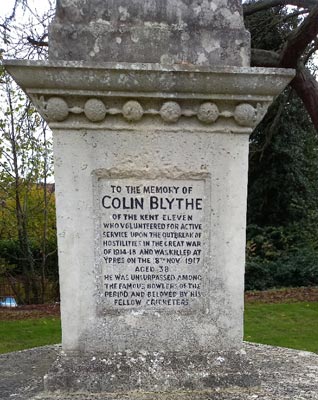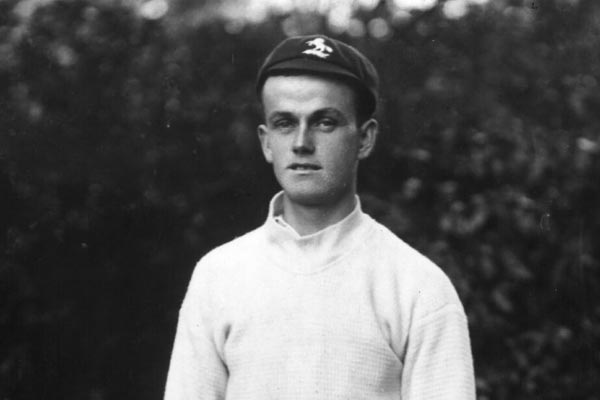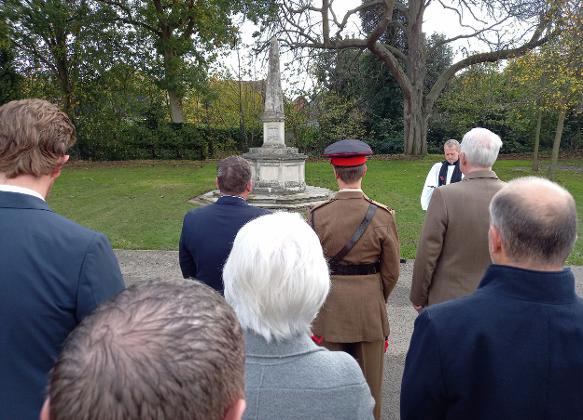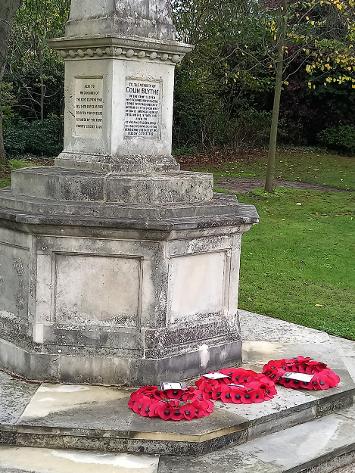THE BLYTHE MEMORIAL


-----
COLIN BLYTHE BIOGRAPHY
Lord Harris, Lord High Everything at Kent for 50 years, felt that one man in particular deserved much of the credit for bringing the championship title to Kent for the first time in 1906. He was Colin Blythe, the left arm spinner who always wore his cap at a jaunty angle, whether bowling, batting or fielding. Blythe, known to all his team-mates and admirers as ‘Charlie’, for reasons that have never been clear, was born at Deptford on 30th May 1879. His parents, Walter and Elizabeth, were not rich – his father worked as a manufacturing hand at Woolwich Arsenal – and young Colin was sent to school at Alverton Street School in Deptford. He left school as soon as he could, and joined his father as an engineer at Woolwich Arsenal. Blythe was never a strong man, suffering from a form of epilepsy throughout his life, but he had two great loves in his life, cricket and music. He was a fine violinist, who played semi-professionally in orchestras when cricket permitted, but his epilepsy meant that he often had to miss a number of matches. His cricket career, wonderful though it was, might have been even more successful had it not been for his debilitating medical condition.
He was discovered in 1897, at the Rectory Field in Blackheath, where Blythe had gone to watch Kent play Somerset. While there, he asked if he could bowl in the nets at Walter Wright, the fast-medium opening bowler for Kent, which he did, in his ordinary shoes and working clothes. Kent staff watching liked what they saw and as a result of this little spell, he was invited to come to Tonbridge to join the newly established Nursery. It was a major decision for Blythe to give up his job at Woolwich Arsenal, but he loved cricket more than munitions, and he took the risk. In 1899 he made his first-class debut for Kent against Yorkshire at Tonbridge. He was an instant success, clean bowling the Yorkshire batsman Frank Mitchell with the first ball he bowled, but that was almost the extent of his success in the game. Blythe is one of only three Kent bowlers to have taken a wicket with the first ball they bowled in first-class cricket, the others being the far less renowned George McCanlis, and Gerald Hough, who never took another wicket after that first ball success against Essex in 1919.
He ended the season with 14 wickets for 310 runs, and Wisden commented that ‘the pressing need of Kent is new professional bowling’, especially slow bowling. ‘Blythe may, of course, develop into the man required, but he has not yet done enough to justify one in predicting a great future for him’. In 1900, Blythe took exactly 100 more wickets than in 1899. Wisden was now able to be more effusive about Kent’s young left arm spinner. ‘His brilliant form came as quite a surprise to the general body of cricketers. Probably those who knew his skill were prepared for what he did, but to outsiders he was a revelation’. His easy action meant that he could bowl for hours without tiring, and although his natural finger-spinning action tended to take the ball away from the right-handed batsman, it was the ball that went straight on with the arm that caused the most difficulty and captured many of his wickets.
He was chosen to tour Australia in 1901-02 with Archie MacLaren’s MCC team, and he played for England for the first time. In the First Test, at Sydney, which England won by an innings, Blythe not only took 7 wickets for 56, but also equalled his highest first-class score to date, 20. Back in England in 1902, Blythe was back to his best form, and finished the season with 127 wickets. In 1903, he improved yet further, taking 142 wickets during the summer and achieving his first nine-wicket analysis, 9 for 67 against Essex in the first game of Canterbury Week. As a result of his bowling that summer, Wisden chose him as one of their Five Cricketers Of The Year, noting that as far as Kent were concerned, ‘for the large majority of their victories, the team were indebted to this young cricketer’. Wisden also paid him the great compliment of quoting Ranjitsinhji’s opinion that he was more difficult to play than Wilfred Rhodes.
Blythe had a successful tour of South Africa in the winter of 1905/06, but back in England, 1906 was a less prolific season, with only 111 wickets to his name. This was largely because he was forced to miss four county games from mid-June to mid-July when he opened a cut on his hand while fielding against Hampshire at Tonbridge, and the injury proved slow to heal. But he was back in harness well in time for Canterbury Week. The rest of the summer was an enjoyable march to glory for Blythe and all his team-mates.
In 1907, Blythe achieved his best analysis, 10 for 30 against Northamptonshire at Northampton. It was an astonishing game, as rain took out half of the first day and all of the second, but still Kent forced a win. After Kent had made 254 all out in their first innings, Blythe came into his own. Bowling unchanged throughout the two innings, he finished the game with 17 wickets for 48 runs, all taken in one day. At one stage in their first innings, Northamptonshire had lost seven wickets with just four runs on the board, and two of them were leg byes. In all cricket, only Jim Laker, with 19 wickets for 90 runs in the Old Trafford Test against Australia in 1956, has achieved better match figures than Blythe’s, and only Hedley Verity and Tom Goddard have equalled his feat of taking 17 wickets in a day.
1907 was the first of four hugely prolific seasons for Blythe. Before the season began, he married Miss Gertie Brown at the registry office in Tonbridge on March 11, and perhaps spurred on by the contentment of a settled home life, took 183 wickets that year, 197 in 1908, 215 in 1909, and 175 in 1910. He took a further 91 wickets on overseas tours in the winters of 1907/08 and 1909/10, a total of 861 wickets in four years. Kent, needless to say, benefited hugely from his success, and took the title in 1909 and 1910. Not that he really slowed down in the years up to the war – he took 653 wickets in the final four years of his career. But more than the number of wickets he took was the style in which he took them, in which he played cricket and conducted every aspect of his life. He was every boy’s hero. As Vanity Fair wrote of him in 1910, ‘Every schoolboy knows something of Blythe, and treasures it up with the diligent care all too soon to be transferred to politics or petticoats’.
Blythe’s career ran in parallel with that of Wilfred Rhodes of Yorkshire, who was generally considered to be at least Blythe’s equal as a left arm spinner, and was certainly a much better batsman, and this unfortunate coincidence, alongside Blythe’s continuing health issues, limited his Test appearances. Rhodes, who made his first appearance for Yorkshire one year before Blythe, in 1898, and continued playing into his fifties in 1930, took more wickets than anybody else in the history of the game, but at an average very similar to Blythe’s, both men averaging under 17 runs per wicket. Not that Rhodes had it all his own way. Wisden noted that the Yorkshireman’s ‘continued advance as a batsman did not compensate for his marked decline as a bowler’. The England selectors picked Blythe over Rhodes for the matches against South Africa in 1907, and were rewarded by Blythe’s 26 wickets at 10 runs each in just three games. In the Second Test that summer, he took 8 for 59 and 7 for 40, the first time anybody had ever taken fifteen wickets in a Test in England.
Jack Hobbs, writing in The Cricketer in 1925, said that ‘what I think many people did not realise was that Blythe could not only spin and swing the ball, but was remarkably clever in flighting it, and to this I ascribe the fact that the Kent slow bowler was almost equally effective, compared with other bowlers, on a good hard wicket. On soft wickets he was sometimes unplayable’. The article was entitled Bowlers I Dreaded Facing. Jack Hobbs, the most prolific batsman in cricket history, put Charlie Blythe at the top of his list.
Blythe, aged 35 and an epileptic, did not have to volunteer for service in the Great War, but although it took him several attempts to persuade the army he was fit for service, he joined the Kent Fortress Engineers. In late 1917, they were posted to France, shortly after Blythe had played his last game of organised cricket, for the Army and Navy against an Australian and South African side on 18 August. Remarkably, although Wisden noted that Blythe ‘was not really well enough to play’, he was still deemed well enough to go to fight at Passchendaele. On 8 November 1917, while working one evening on the front line, a shell landed behind the British lines and Sergeant Blythe and two others were killed instantly.
The death of Charlie Blythe caused an outpouring of sadness and regret, and not just among the cricket fraternity. ‘His personal qualities were such that he was universally popular’, noted the Kent & Sussex Courier, an understatement about a sweet-natured cricketer, loved by his fellow cricketers, whether team-mates or opponents, and by all who came to see him play. He was generally considered the most exciting bowler of his age to watch, imaginative and full of variations and never afraid to take on the big hitters.
-----

Nov 2022: Remembrance Service at the Memorial.

-----
The General Committee of Kent CCC passed a resolution on 12 December 1917, to create a permanent memorial to Blythe, and in August 1919 a Memorial Fountain was unveiled at the St. Lawrence Ground, erected to the memory of Blythe and other Kent cricketers who died in the Great War. Each year, on November 8th, a ceremony is held at the Memorial, where wreaths are laid by the President and captain of the county club, as well as by representatives of the local regiment. The inscription is simple: To the memory of Colin Blythe of the Kent Eleven, who volunteered for active service upon the outbreak of hostilities in the Great War of 1914-18, and was killed at Ypres on the 8th Nov 1917, aged 38. He was unsurpassed among the famous bowlers of the period and beloved by his fellow cricketers.
OTHER INFORMATION
Colin Blythe Bio (KCCC website)
War Memorials Online resource for the Blythe Memorial.
© Copyright Kent Cricket Heritage Trust